Soldato
- Joined
- 27 Mar 2003
- Posts
- 2,710
So after much procrastination I finally decided it was time I upgraded my case and given my slightly spec'd up system over recent months/years the system needed a case it deserves.
After 14/15 years of faithful service with numerous builds in it I thought it was time to retire my trusty CoolerMaster Stacker ATC-01 full tower case.
While doing this build I thought it would also be a good time to wet my whistle in the water cooling world and it has been a eye opener so this build log will be both about putting things into this case and a my observations as a first time water cooler so that people in a similar position may learn from my mistakes.
The system that will be going into this case is as follows:
Intel I7-5820K
Gigabyte GA-X99-SLI (Socket 2011-3) motherboard
4 x 4GB TeamGroup Elite 2400Mhz Ram (Quad channel kit)
Inno3D RTX 2080 Twin x2 OC
1 x Samsung Evo 850 500GB (SSD)
1 x Samsung 830 Desktop 128GB (SSD)
2 x 4TB HGST 3.5" SATA drives
Coolermaster Real Power M1000 PSU
Lian Li PC-O11 Dynamic Razer Edition
Now for the water cooling components (All EK Water Blocks - unless otherwise stated):
1 x EK-Velocity RGB Intel CPU Water Block Nickel + Plexi
1 x EK-CoolStream SE 360 (Slim triple) Radiator
1 x EK-XRES 140 Revo RGB PWM (inc pump)
3 x EK-Vardar EVO 120mm RGB Fan
6 x EK-ACF Compression Fitting 10/16mm - Black Nickel
1 x EK-Cryofuel Solid Electric Purple 1 litre Premix fluid
1 x Filling Bottle
1 x EK-Duraclear Tubing 16/10 - Clear 3M
1 x XPSC Heavy Duty Host Cutter
1 x EK-ATX Bridging Plug (24 pin)
So I thought while I was at it and to try and give this a clean look I would also go with some cable mod cable extensions for both the psu and my sata cables
1 x CableMod ModMesh Cable Extension Kit
6 x CableMod Right Angle SATA 3 Cable
I will be showing the build process in a series of photos and my learnings as part of this build as going from air cooling to water cooling has been an eye opener indead.
Although I have started this build I will add photo's and more details as I go when they have backed up google photo's.
I already have a number of things I have learnt while doing the initial system transfer so that is where I will start.
After 14/15 years of faithful service with numerous builds in it I thought it was time to retire my trusty CoolerMaster Stacker ATC-01 full tower case.
While doing this build I thought it would also be a good time to wet my whistle in the water cooling world and it has been a eye opener so this build log will be both about putting things into this case and a my observations as a first time water cooler so that people in a similar position may learn from my mistakes.
The system that will be going into this case is as follows:
Intel I7-5820K
Gigabyte GA-X99-SLI (Socket 2011-3) motherboard
4 x 4GB TeamGroup Elite 2400Mhz Ram (Quad channel kit)
Inno3D RTX 2080 Twin x2 OC
1 x Samsung Evo 850 500GB (SSD)
1 x Samsung 830 Desktop 128GB (SSD)
2 x 4TB HGST 3.5" SATA drives
Coolermaster Real Power M1000 PSU
Lian Li PC-O11 Dynamic Razer Edition
Now for the water cooling components (All EK Water Blocks - unless otherwise stated):
1 x EK-Velocity RGB Intel CPU Water Block Nickel + Plexi
1 x EK-CoolStream SE 360 (Slim triple) Radiator
1 x EK-XRES 140 Revo RGB PWM (inc pump)
3 x EK-Vardar EVO 120mm RGB Fan
6 x EK-ACF Compression Fitting 10/16mm - Black Nickel
1 x EK-Cryofuel Solid Electric Purple 1 litre Premix fluid
1 x Filling Bottle
1 x EK-Duraclear Tubing 16/10 - Clear 3M
1 x XPSC Heavy Duty Host Cutter
1 x EK-ATX Bridging Plug (24 pin)
So I thought while I was at it and to try and give this a clean look I would also go with some cable mod cable extensions for both the psu and my sata cables
1 x CableMod ModMesh Cable Extension Kit
6 x CableMod Right Angle SATA 3 Cable
I will be showing the build process in a series of photos and my learnings as part of this build as going from air cooling to water cooling has been an eye opener indead.
Although I have started this build I will add photo's and more details as I go when they have backed up google photo's.
I already have a number of things I have learnt while doing the initial system transfer so that is where I will start.






